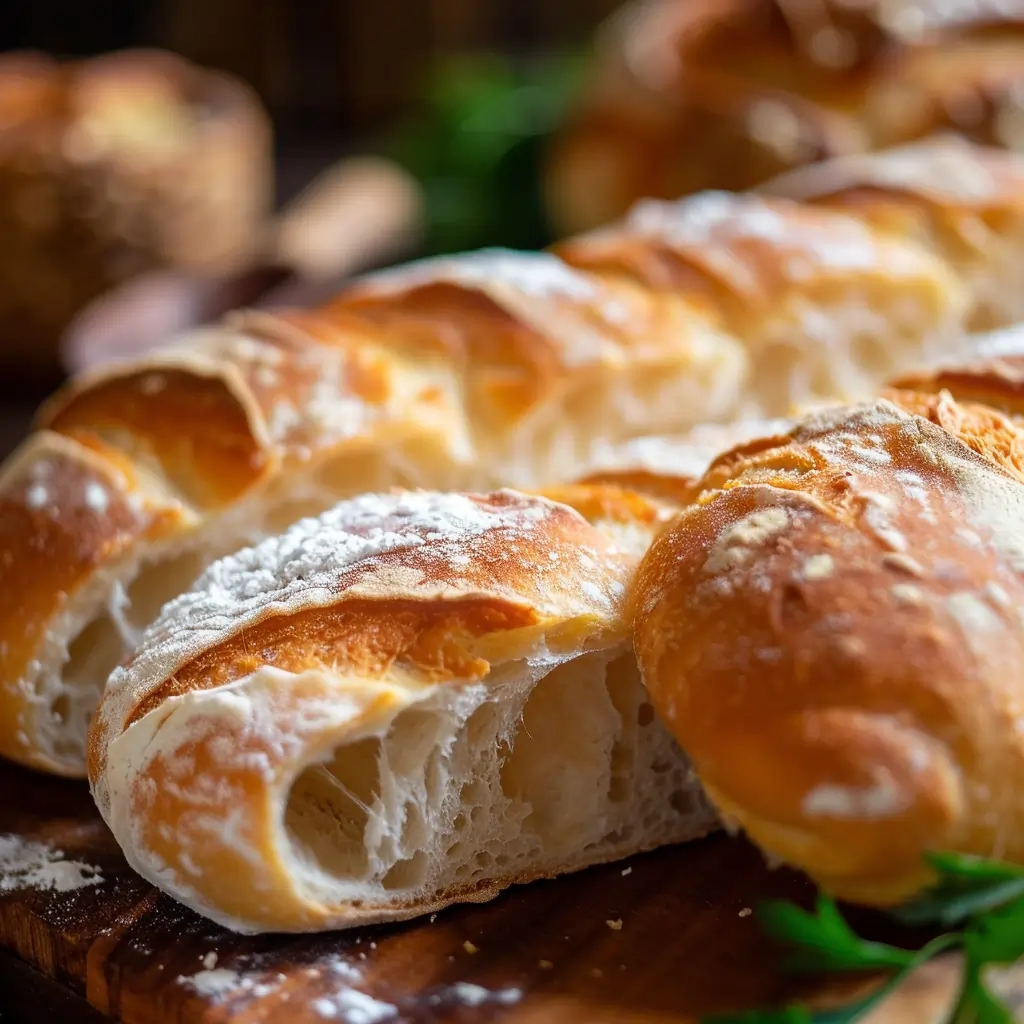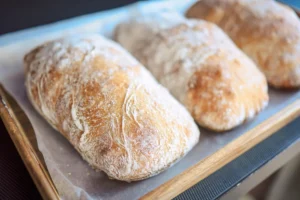Introduction
Ciabatta rolls, with their airy crumb and delightfully crispy crust, are a staple in bakeries worldwide. Originating from Italy, these rolls have become a favorite for sandwiches, dipping in olive oil, or enjoying as-is. Making them at home allows for customization and ensures freshness, making the process both rewarding and enjoyable.
If you’ve ever wondered how to perfect how to make ciabatta rolls, this guide provides all the tips, techniques, and secrets needed to achieve bakery-level results.
What are Ciabatta Rolls?
Ciabatta rolls are Italian bread known for their crispy crust and airy, light texture. These rolls have an elongated shape and are often used for making sandwiches. The name “ciabatta” means “slipper” in Italian, a reference to its shape. In addition, ciabatta is made with a wet dough, which gives it a unique, open crumb structure, making it perfect for soaking up oils, sauces, or spreads. As a result, they’re a popular choice for gourmet sandwiches, subs, and even as a side for soups or salads.
Ciabatta rolls are distinct due to their rustic appearance, with bubbles of air visible throughout the bread. Therefore, they’re often considered a favorite among artisan bread lovers. If you’ve ever wondered how to make ciabatta rolls, you’ll find that the process involves a few simple ingredients, but requires patience and a bit of practice to achieve that perfect texture.
Learning how to make ciabatta rolls at home not only saves money but also guarantees freshness and quality.
Ingredients to Make Ciabatta Rolls
To successfully create delicious ciabatta rolls, you’ll need a few basic ingredients. First, gather the following essentials:
- Flour: A high-protein bread flour is essential for structure and chewiness.
- Yeast: Active dry or instant yeast helps the dough rise.
- Water: Use lukewarm water to activate the yeast properly.
- Salt: It enhances flavor and strengthens the dough.
- Olive oil: This adds richness to the dough and contributes to the bread’s crispy texture.
- Sugar: A small amount of sugar will feed the yeast for a better rise.
Additionally, you may choose to add a bit of semolina flour for dusting the dough, giving the rolls their classic texture. In essence, the key to perfect ciabatta rolls lies in the quality of ingredients and their proportions.
For detailed proportions and variations, check out our comprehensive ciabatta rolls recipe guide.
Tools You’ll Need to Make Ciabatta Rolls
Before you dive into making ciabatta rolls, it’s important to ensure you have the right tools. Having the right equipment will make the process easier and more successful. Here’s what you’ll need:
- Mixing Bowl: A large bowl for mixing the dough.
- Dough Scraper: For handling the wet dough and shaping the rolls.
- Baking Sheet: To bake the ciabatta rolls. You can also use a pizza stone for a crispier crust.
- Proofing Basket (optional): Helps shape the dough and adds a traditional rustic appearance.
- Kitchen Scale: For accurate measurements of ingredients.
- Plastic Wrap or Damp Cloth: For covering the dough during proofing.
In conclusion, these tools will provide you with everything necessary to make ciabatta rolls from start to finish, ensuring a professional result at home.

The Science Behind Ciabatta
Understanding the science behind ciabatta rolls is crucial if you want to make them at home. First, it’s important to understand the high hydration dough, which is a key element in achieving the open crumb texture typical of ciabatta. Because this dough is wetter than many traditional bread doughs, it creates the characteristic holes and chewy texture.
The yeast fermentation process is another factor contributing to the texture and flavor of ciabatta rolls. As the dough ferments, the yeast consumes the sugars, creating gases that cause the dough to rise. The longer the dough rests and ferments, the better the flavor development. Thus, patience is essential when learning how to make ciabatta rolls.
The baking process also plays a role in the final product. The high oven temperature and steam introduced during baking help form the crispy crust, while maintaining the soft, airy interior.
Step-by-Step Guide: How to Make Ciabatta Rolls
Prepare the Dough
- In a large bowl, combine 500g bread flour, 350ml lukewarm water, and 1 tsp salt.
- Sprinkle in 2 tsp instant yeast and 1 tsp sugar.
- Mix the ingredients together until they form a rough dough.
- Add 2 tbsp olive oil and knead the dough until it becomes smooth and elastic. Note that the dough will be wetter than traditional bread dough, so it’s important to keep the dough sticky.
First Proofing
- Cover the dough with a damp cloth or plastic wrap.
- Allow it to rise in a warm place for about 1-2 hours, or until it has doubled in size.
- As a result, you’ll notice that the dough will become bubbly and soft, ready for shaping.
Shape the Ciabatta Rolls
- Gently deflate the dough, and divide it into smaller portions (usually about 6-8 pieces for individual rolls).
- Shape the dough into rough, oval shapes using your hands or a dough scraper. Be careful not to overwork the dough to preserve the airy texture.Steep 4: Second Proofing
- Place the shaped dough onto a well-floured surface or a proofing basket.
- Cover and let it rise for about 45 minutes, or until slightly puffed up.
- During this time, the dough will continue to rise and develop more bubbles.
Bake the Ciabatta Rolls
- Preheat your oven to 475°F (245°C).
- If using a pizza stone, place it in the oven while preheating for the best results.
- Place the rolls on a baking sheet or directly onto the stone.
- To achieve the best texture, introduce steam by placing a pan of hot water at the bottom of the oven, or spritzing water into the oven before closing the door.
- Bake for 20-25 minutes, or until the rolls are golden brown and sound hollow when tapped on the bottom.
Tips for Perfect Ciabatta Rolls
Creating the perfect ciabatta rolls requires attention to detail and proper technique. To begin with, here are essential tips:
- Use high-protein flour: This ensures the dough develops the necessary gluten structure for that signature airy texture.
- Maintain the hydration level: Ciabatta dough is naturally wet and sticky, so don’t be tempted to add more flour.
- Don’t rush the process: Allow the dough to ferment properly, as this enhances flavor and texture.
- Master the folding technique: Folding instead of kneading strengthens the gluten network without overworking the dough.
- Use minimal handling: Excessive handling can deflate the dough, compromising the airy interior.
In addition, baking at a high temperature with steam creates the golden crust synonymous with ciabatta rolls. Learning how to make ciabatta rolls with precision requires practice but is well worth the effort.
Common Mistakes to Avoid
Even seasoned bakers can encounter issues when learning how to make ciabatta rolls. Here’s a list of common pitfalls:
- Adding too much flour: A sticky dough might feel challenging, but adding more flour can lead to dense rolls.
- Skipping the fermentation step: Shortening this process will result in bland-tasting bread.
- Overworking the dough: Unlike traditional bread, ciabatta requires minimal kneading to preserve its airy structure.
- Not preheating the oven properly: Baking ciabatta requires an evenly heated oven to achieve the perfect crust.
- Ignoring steam: Without steam, the crust may turn too hard or dull.
Therefore, always stick to tried-and-true techniques when exploring how to make ciabatta rolls to ensure consistent success.

Variations of Ciabatta Rolls
Once you’ve mastered the basics of how to make ciabatta rolls, explore these creative variations:
- Herbed ciabatta rolls: Add fresh rosemary, thyme, or basil to the dough for a fragrant twist.
- Whole wheat ciabatta: Substitute some white flour with whole wheat flour for a nuttier flavor and added fiber.
- Olive-studded ciabatta: Incorporate chopped black or green olives for a Mediterranean flair.
- Cheese-filled ciabatta: Fold shredded Parmesan, Asiago, or cheddar into the dough for a cheesy delight.
- Sun-dried tomato ciabatta: Mix in finely chopped sun-dried tomatoes for a tangy, savory variation.
Serving Suggestions
Ciabatta rolls are versatile and can be served in numerous ways:
- As sandwich bases: Their airy crumb and crisp crust are ideal for layering deli meats, cheeses, and vegetables.
- Paired with soups or stews: Dip these rolls into hearty soups for a comforting meal.
- For breakfast: Toast and top with butter, jam, or avocado for a quick morning treat.
- Used in appetizers: Slice thinly, toast, and serve with dips like hummus, tapenade, or bruschetta topping.
- On their own: Enjoy fresh ciabatta rolls warm from the oven with a drizzle of olive oil.
Notably, knowing how to make ciabatta rolls ensures you always have a delicious and adaptable bread option.
Storage and Reheating
Proper storage is key to preserving the quality of your homemade ciabatta rolls.
- Store rolls in a paper bag or bread box for up to two days at room temperature.
- For longer storage, wrap them tightly in plastic wrap and freeze for up to three months.
- To reheat frozen ciabatta rolls, let them thaw at room temperature before placing them in a preheated oven at 350°F for 5-10 minutes.
- Avoid microwaving, as it can make the bread rubbery.
Nutritional Information
Understanding the nutritional profile of how to make ciabatta rolls is beneficial for mindful eating:
- Calories: A standard ciabatta roll contains approximately 160-200 calories.
- Carbohydrates: Ciabatta is a carb-rich bread, with about 30-35g per roll.
- Protein: High-protein flour contributes around 6-8g per roll.
- Fat content: Minimal fat, typically 1-2g per roll unless enriched with ingredients like cheese or olives.
- Fiber: Whole wheat variations offer higher fiber content compared to traditional white ciabatta.
FAQs pertaining to how to make ciabatta rolls :
What Makes Ciabatta Different from Regular Bread?
Ciabatta stands out due to its unique texture and composition. It is known for its airy, open crumb and crisp crust, which result from the high hydration of the dough. Unlike regular bread, ciabatta has minimal kneading and relies on folding to develop structure. Its flavor is also distinct due to the slow fermentation process, which enhances its slightly tangy taste. In comparison, traditional bread often has a denser crumb and may lack the same chewy and light texture.
Is Ciabatta Bread Better for You Than Regular Bread?
The health benefits of ciabatta versus regular bread depend on the ingredients and preparation. Ciabatta made from refined white flour is similar in nutritional value to most white bread, offering carbohydrates and minimal fiber. However, whole wheat ciabatta provides more nutrients and fiber, making it a healthier option. That being said, ciabatta is lower in fat and sugar compared to enriched bread, which could be beneficial if you’re looking for a simpler bread option.
Does Ciabatta Need to Be Toasted?
Ciabatta does not need to be toasted but benefits greatly from it. Toasting enhances its natural crispness and warms the soft interior, making it perfect for sandwiches, dips, or spreads.
Additionally, toasting adds a rich flavor dimension to the bread, highlighting its slightly tangy undertones. Fresh ciabatta, however, can be enjoyed without toasting if it’s served on the same day it is baked.
How Long to Heat Ciabatta in the Oven?
To reheat ciabatta in the oven:
- Preheat the oven to 350°F (175°C).
- Wrap the ciabatta loosely in foil to prevent excessive drying.
- Heat for 5-10 minutes, depending on the size of the rolls or loaf.
Remember, reheating ciabatta restores its crusty texture and warms the soft interior, making it as enjoyable as freshly baked.
Are Ciabatta Rolls Ready to Eat?
Freshly baked ciabatta rolls are ready to eat once cooled. Store-bought ciabatta rolls, particularly those labeled as “par-baked,” need to be heated in the oven to finish cooking. If you’re unsure, check the packaging for instructions.
When properly baked, ciabatta rolls should have a firm crust and an airy, chewy interior.
How to Toast Ciabatta Bread in a Pan?
To toast ciabatta bread in a pan:
- Slice the ciabatta loaf or rolls into desired thickness.
- Preheat a skillet or griddle over medium heat.
- Brush the bread lightly with olive oil or butter for added flavor.
- Place the slices in the pan and toast for 2-3 minutes per side, pressing gently with a spatula for even browning.
Should Ciabatta Be Hard or Soft?
Ciabatta should have a firm and crisp crust on the outside while being soft and airy on the inside. If the crust is too hard or the interior is overly dense, this might indicate issues such as over-baking, insufficient hydration, or improper fermentation. Ideally, the bread should strike a balance, offering a satisfying crunch with each bite while remaining chewy and light within.
Conclusion
Mastering how to make ciabatta rolls may seem intimidating, but with the right techniques and a little patience, anyone can succeed. By avoiding common mistakes, experimenting with variations, and serving them creatively, you’ll elevate your baking skills and delight your taste buds. Remember, proper storage and reheating ensure your efforts remain enjoyable for days to come.
In summary, ciabatta rolls are not just bread—they’re a versatile and delicious addition to any meal. Dive in, practice, and enjoy the satisfaction of crafting these iconic rolls at home!



1 thought on “How to Make Ciabatta Rolls: A Step-by-Step Guide to Perfect Homemade Bread”